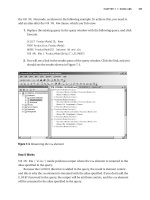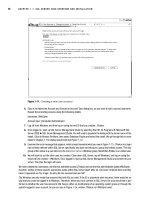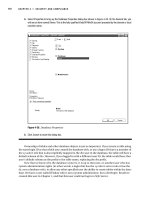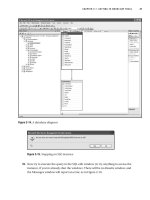Beginning Java SE 6 Platform From Novice to Professional phần 2 ppsx
Bạn đang xem bản rút gọn của tài liệu. Xem và tải ngay bản đầy đủ của tài liệu tại đây (364.59 KB, 51 trang )
// Create a true ownerless Swing dialog.
JDialog d2 = new JDialog ((Window) null, "Dialog 2");
d2.setName ("Dialog 2");
// Create an ownerless frame.
Frame f = new Frame ();
f.setName ("Frame 1");
// Create a window owned by the frame.
Window w1 = new Window (f);
w1.setName ("Window 1");
// Create an ownerless window.
Window w2 = new Window (null);
w2.setName ("Window 2");
// Output lists of all windows, ownerless windows, and frame windows.
System.out.println ("ALL WINDOWS");
Window [] windows = Window.getWindows ();
for (Window window: windows)
System.out.println (window.getName ()+": "+window.getClass ());
System.out.println ();
System.out.println ("OWNERLESS WINDOWS");
Window [] ownerlessWindows = Window.getOwnerlessWindows ();
for (Window window: ownerlessWindows)
System.out.println (window.getName ()+": "+window.getClass ());
System.out.println ();
System.out.println ("FRAME WINDOWS");
Frame [] frames = Frame.getFrames ();
for (Frame frame: frames)
System.out.println (frame.getName ()+": "+frame.getClass ());
}
}
CHAPTER 1 ■ INTRODUCING JAVA SE 628
830-X CH01.qxd 9/18/07 9:22 PM Page 28
After compiling the source code and running this application, you’ll discover the
following output, which reveals that Dialog 1 is not a true ownerless window:
ALL WINDOWS
frame0: class javax.swing.SwingUtilities$SharedOwnerFrame
Dialog 1: class javax.swing.JDialog
Dialog 2: class javax.swing.JDialog
Frame 1: class java.awt.Frame
Window 1: class java.awt.Window
Window 2: class java.awt.Window
OWNERLESS WINDOWS
frame0: class javax.swing.SwingUtilities$SharedOwnerFrame
Dialog 2: class javax.swing.JDialog
Frame 1: class java.awt.Frame
Window 2: class java.awt.Window
FRAME WINDOWS
frame0: class javax.swing.SwingUtilities$SharedOwnerFrame
Frame 1: class java.awt.Frame
Navigable Sets
Chapter 2 introduces Java SE 6’s enhanced collections framework. One enhancement
worth mentioning here is a new
java.util.NavigableSet<E> interface, which extends the
older
java.util.SortedSet<E> interface and facilitates navigating through an ordered set-
based collection.
A navigable set can be accessed and traversed in ascending order via the
Iterator<E>
iterator()
method, and in descending order via the Iterator<E> descendingIterator()
method. It can return the closest matches for given search targets via methods public E
ceiling(E e), public E floor(E e), public E higher(E e), and public E lower(E e). By
default, these closest-match methods find the closest match in ascending order. To find
a closest match in descending order, first obtain a reverse-order view of the set via the
NavigableSet<E> descendingSet() method. Listing 1-6 presents an application that
demonstrates
descendingSet() and the four closest-match methods, with comments
that describe each closest-match method in detail.
CHAPTER 1 ■ INTRODUCING JAVA SE 6 29
830-X CH01.qxd 9/18/07 9:22 PM Page 29
Listing 1-6. CityNavigator.java
// CityNavigator.java
import java.util.*;
public class CityNavigator
{
static NavigableSet<String> citiesSet;
public static void main (String [] args)
{
String [] cities =
{
"Beijing",
"Berlin",
"Baghdad",
"Buenos Aires",
"Bangkok",
"Belgrade"
};
// Create and populate a navigable set of cities.
citiesSet = new TreeSet<String> ();
for (String city: cities)
citiesSet.add (city);
// Dump the city names in ascending order. Behind the scenes, the
// following code is implemented in terms of
//
// Iterator iter = citiesSet.iterator ();
// while (iter.hasNext ())
// System.out.println (iter.next ());
System.out.println ("CITIES IN ASCENDING ORDER");
for (String city: citiesSet)
System.out.println (" "+city);
System.out.println ();
// Dump the city names in descending order. Behind the scenes, the
// following code is implemented in terms of
CHAPTER 1 ■ INTRODUCING JAVA SE 630
830-X CH01.qxd 9/18/07 9:22 PM Page 30
//
// Iterator iter = citiesSet.descendingSet.iterator ();
// while (iter.hasNext ())
// System.out.println (iter.next ());
System.out.println ("CITIES IN DESCENDING ORDER");
for (String city: citiesSet.descendingSet ())
System.out.println (" "+city);
System.out.println ();
// Demonstrate the closest-match methods in ascending order set.
System.out.println ("CLOSEST-MATCH METHODS/ASCENDING ORDER DEMO");
outputMatches ("Berlin");
System.out.println ();
outputMatches ("C");
System.out.println ();
outputMatches ("A");
System.out.println ();
// Demonstrate closest-match methods in descending order set.
citiesSet = citiesSet.descendingSet ();
System.out.println ("CLOSEST-MATCH METHODS/DESCENDING ORDER DEMO");
outputMatches ("Berlin");
System.out.println ();
outputMatches ("C");
System.out.println ();
outputMatches ("A");
System.out.println ();
}
static void outputMatches (String city)
{
// ceiling() returns the least element in the set greater than or equal
// to the given element (or null if the element does not exist).
System.out.println (" ceiling('"+city+"'): "+citiesSet.ceiling (city));
CHAPTER 1 ■ INTRODUCING JAVA SE 6 31
830-X CH01.qxd 9/18/07 9:22 PM Page 31
// floor() returns the greatest element in the set less than or equal to
// the given element (or null if the element does not exist).
System.out.println (" floor('"+city+"'): "+citiesSet.floor (city));
// higher() returns the least element in the set strictly greater than
// the given element (or null if the element does not exist).
System.out.println (" higher('"+city+"'): "+citiesSet.higher (city));
// lower() returns the greatest element in the set strictly less than
// the given element (or null if the element does not exist).
System.out.println (" lower('"+city+"'): "+citiesSet.lower (city));
}
}
As shown in the source code, the closest-match methods return set elements that
satisfy various conditions. For example,
lower() returns the element that is greater than
all other set elements, except for the element described by
lower()’s argument; the
method returns null if there is no such element. Although this description is intuitive
when you consider a set that is ordered in ascending order, intuition fails somewhat
when you consider the set ordered in descending order. For example, in the following
output, Belgrade is lower than Berlin in ascending order, and Buenos Aires is lower than
Berlin in descending order:
CITIES IN ASCENDING ORDER
Baghdad
Bangkok
Beijing
Belgrade
Berlin
Buenos Aires
CHAPTER 1 ■ INTRODUCING JAVA SE 632
830-X CH01.qxd 9/18/07 9:22 PM Page 32
CITIES IN DESCENDING ORDER
Buenos Aires
Berlin
Belgrade
Beijing
Bangkok
Baghdad
CLOSEST-MATCH METHODS/ASCENDING ORDER DEMO
ceiling('Berlin'): Berlin
floor('Berlin'): Berlin
higher('Berlin'): Buenos Aires
lower('Berlin'): Belgrade
ceiling('C'): null
floor('C'): Buenos Aires
higher('C'): null
lower('C'): Buenos Aires
ceiling('A'): Baghdad
floor('A'): null
higher('A'): Baghdad
lower('A'): null
CLOSEST-MATCH METHODS/DESCENDING ORDER DEMO
ceiling('Berlin'): Berlin
floor('Berlin'): Berlin
higher('Berlin'): Belgrade
lower('Berlin'): Buenos Aires
ceiling('C'): Buenos Aires
floor('C'): null
higher('C'): Buenos Aires
lower('C'): null
ceiling('A'): null
floor('A'): Baghdad
higher('A'): null
lower('A'): Baghdad
CHAPTER 1 ■ INTRODUCING JAVA SE 6 33
830-X CH01.qxd 9/18/07 9:22 PM Page 33
■Note Here are a few other interesting changes in Java SE 6:
• Java SE 6 changes the class file version number to 50.0 because it supports split verification
(see Appendix B).
• Java SE 6’s
jarsigner, keytool, and kinit security tools no longer echo passwords to the
screen.
• The
javax.swing.text.Segment class, which allows fast access to a segment of text, now
implements the
CharSequence interface. You can use Segment in regular-expression contexts,
for example.
Java SE 6, Update 1 and Update 2
Following the initial release of Java SE 6 (which is the focus of this book), Sun released
its first Java SE 6 update to introduce a number of bug fixes. This update release specifies
6u01 as its external version number, and 1.6.0_01-b06 (where b stands for build) as its
internal version number.
One bug that has been fixed in 6u01 concerns memory leak problems with several
methods. For example, the
Thread class specifies a public static Map<Thread,
StackTraceElement[]> getAllStackTraces() method that returns a map of stack traces
for all live threads. Also, the
java.lang.management.ThreadMXBean interface specifies several
getThreadInfo() methods that return thread information. According to Bug 6434648
“Native memory leak when use Thread.getAllStackTraces(),” all of these methods have a
memory leak that leads to an
OutOfMemoryError. You can reproduce this problem, which has
been solved in this update release, by running the following application (which might run
for a considerable period of time before
OutOfMemoryError is thrown) on the initial release
of Java SE 6:
public class TestMemoryLeak
{
public static void main(String[] args)
{
while (true)
{
Thread.getAllStackTraces();
}
}
}
CHAPTER 1 ■ INTRODUCING JAVA SE 634
830-X CH01.qxd 9/18/07 9:22 PM Page 34
Another bug that has been fixed in 6u01 is Bug 6481004 “SplashScreen.getSplashScreen()
fails in Web Start context.” According to this bug, migrating a stand-alone application
that uses the Splash Screen API to Java Web Start results in a
java.security.
AccessControlException being thrown. This exception is thrown as a result of the
System.loadLibrary("splashscreen") method call in the public static synchronized
SplashScreen getSplashScreen() method not being placed inside a doPrivileged() block.
The Java SE 6 Update Release Notes page (
/>ReleaseNotes.html) provides a complete list of all the bugs that have disappeared in
the 6u01 update.
While this chapter was being written, a second Java SE 6 update was released.
Although this update was rumored to contain a slimmed-down JRE, as pointed out
by the posting on TheServerSide.com titled “Rumor: Java 6 update 2 will be 2-4MB?”
(
the second update
offered nothing quite so dramatic. This rumor was most likely based on the much-
discussed Consumer JRE, which Chet Haase discusses in his “Consumer JRE: Leaner,
Meaner Java Technology” article (
/>javase/consumerjre/
).
To see what the second update has to offer, check out Sun’s Java SE 6 Update Release
Notes page.
Summary
Java SE 6 (formerly known as Mustang) officially arrived on December 11, 2006. This
release contains many new and improved features that will benefit Java developers for
years to come.
Java SE 6 was developed under JSR 270, which presents various themes. These
themes include compatibility and stability; diagnosability, monitoring, and manage-
ment; ease of development; enterprise desktop; XML and web services; and
transparency.
JSR 270 identifies various component JSRs. These JSRs include JSR 105 XML Digital
Signature APIs, JSR 199 Java Compiler API, JSR 202 Java Class File Specification Update,
JSR 221 JDBC 4.0 API Specification, JSR 222 Java Architecture for XML Binding (JAXB) 2.0,
JSR 223 Scripting for the Java Platform, JSR 224 Java API for XML-Based Web Services
(JAX-WS) 2.0, JSR 268 Java Smart Card I/O API, and JSR 269 Pluggable Annotation Pro-
cessing API. Although not identified by JSR 270, JSR 173 Streaming API for XML, JSR 181
Web Services Metadata for the Java Platform, and JSR 250 Common Annotations for the
Java Platform are also component JSRs.
Java SE 6 provides many features that set it apart from its predecessors. Some of
these features were explored in this chapter, and include a trio of new action keys and a
method to hide/show action text, the ability to clear a button group’s selection, reflection
CHAPTER 1 ■ INTRODUCING JAVA SE 6 35
830-X CH01.qxd 9/18/07 9:22 PM Page 35
enhancements, the GroupLayout layout manager, an Image I/O GIF writer plug-in,
incremental improvements to the
String class, LCD text support, new NumberFormat
methods for working with rounding modes, an improved File class infrastructure,
window icon images, the ability to specify a minimum window size, an interruptible
I/O switch for Solaris,
DeflatorInputStream and InflatorOutputStream classes added to
the
java.util.zip package, ownerless windows, and navigable sets.
Following the initial release of Java SE 6 (which is the focus of this book), Sun
released a pair of updates that primarily fix bugs.
Test Your Understanding
How well do you understand Java SE 6 thus far? Test your understanding by answering
the following questions and performing the following exercises. (The answers are
presented in Appendix D.)
1. Why does Sun refer to Java SE 6 instead of J2SE 6.0?
2. Identify the themes of Java SE 6.
3. Does Java SE 6 include internationalized resource identifiers (IRIs)?
4. What is the purpose of
Action’s new DISPLAYED_MNEMONIC_INDEX_KEY constant?
5. Why should you create a Swing program’s GUI only on the event-dispatching
thread?
6. How do you establish a window’s minimum size?
7. Describe each of
NavigableSet<E>’s closest-match methods.
8. Does
public JDialog(Frame owner) create a true ownerless window when owner
is null?
CHAPTER 1 ■ INTRODUCING JAVA SE 636
830-X CH01.qxd 9/18/07 9:22 PM Page 36
37
Core Libraries
Java’s core libraries support mathematics, input/output (I/O), collections, and more.
Java SE 6 updates existing core libraries and integrates new libraries into the core. This
chapter explores the following core library topics:
•
BitSet enhancements
• Compiler API
• I/O enhancements
• Mathematics enhancements
• New and improved collections
• New and improved concurrency
• Extension mechanism and ServiceLoader API
BitSet Enhancements
The java.util.BitSet class implements a growable vector of bits. Because of its compact-
ness and other advantages, this data structure is often used to implement an operating
system’s priority queues and facilitate memory page allocation. Unix-oriented file sys-
tems also use bitsets to facilitate the allocation of inodes (information nodes) and disk
sectors. And bitsets are useful in Huffman coding, a data-compression algorithm for
achieving lossless data compression.
CHAPTER 2
830-X CH02.qxd 9/16/07 4:18 PM Page 37
Although no new features have been added to BitSet, Java SE 6 has improved this
class in the following ways:
• According to Bug 4963875 “Reduction of space used by instances of java.util.BitSet,”
the
clone() method now returns a clone that can be smaller than the original bitset;
bs.size() == bs.clone().size() is no longer guaranteed to be true. Also, a serialized
bitset can be smaller. These optimizations reduce wasted space. However, a cloned
or serialized bitset is not trimmed if the bitset was created via
BitSet(int nbits), and
its implementation size has not changed since creation.
• The
equals(Object obj) method is now speed-optimized for sparse bitsets (only a
few bits are set). It returns false when the number of words in the logical lengths
of the bitsets being compared differ. Please consult Bug 4979017
“java.util.BitSet.equals(Object) can be optimized” for more information.
• The
hashCode() method has been speed-optimized to hash only the used part of a
bitset (the bitset’s logical length), as opposed to the entire bitset (its implementa-
tion size). You can find more information about this optimization by reading Bug
4979028 “BitSet.hashCode() unnecessarily slow due to extra scanning of zero bits.”
• The
toString() method has been speed-optimized for large sparse bitsets. Check
out Bug 4979031 “BitSet.toString() is too slow on sparse large bitsets” for more
information.
• Some of
BitSet’s methods now call various methods in the Long class instead of
implementing equivalent methods. For example, the
BitSet class’s public int
nextSetBit(int fromIndex)
method invokes the Long class’s public static int
numberOfTrailingZeroes(long i) method. This results in a simpler, faster, and
smaller
BitSet implementation. Bug 5030267 “Use new static methods
Long.highestOneBit/Long.bitCount in java.util.BitSet” provides more
information. Also, you might want to check out the
BitSet.java source file.
• Previous violations of
BitSet’s internal invariants are no longer tolerated. For
example, given
bs.set(64,64);, bs.length() now returns 0 (instead of 64) and
isEmpty() returns true (instead of false). More information can be found by
reviewing Bug 6222207 “BitSet internal invariants may be violated.”
Compiler API
The ability to dynamically compile Java source code is needed in many situations. For
example, the first time a web browser requests a JavaServer Pages (JSP)-based document,
the JSP container generates a servlet and compiles the servlet’s code.
CHAPTER 2 ■ CORE LIBRARIES38
830-X CH02.qxd 9/16/07 4:18 PM Page 38
Prior to Java 1.2, you could achieve dynamic compilation only by creating a tempo-
rary
.java file and invoking javac via Runtime.exec(). Alternatively, you could access
javac internals. The first approach was problematic because of platform-specific process
behavior and applet security restrictions. The latter approach suffered from being undoc-
umented and compiler-specific.
Java 1.2 let you programmatically access the compiler via the JDK’s
tools.jar file.
This access remained undocumented until Java 5 debuted. The following static methods
in
tools.jar’s com.sun.tools.javac.Main class let you access the compiler:
•
public static int compile(String[] args)
• public static int compile(String[] args, PrintWriter out)
The args parameter identifies the command-line arguments normally passed to
javac. The out parameter specifies the location of compiler diagnostic output (error
and warning messages). Each method returns the same value as
javac’s exit code.
As useful as these methods are, they are limited in the way they interact with their
environment. For starters, they input source code from files and output compiled code
to files. Also, they report errors to a single output stream—no mechanism exists to return
diagnostics as structured data. I refer you to JSR 199 (
/>detail?id=199) for more information.
To address this limitation, Sun has integrated the Compiler API into Java SE 6’s core
libraries. This API offers the following:
• Programmatic access to the compiler
• Ability to override the manner in which the compiler reads and writes source and
class files
• Access to structured diagnostic information
Access to the Compiler and Other Tools
The Compiler API is hosted by the javax.tools package, which is designed to let
programs invoke various tools, beginning with compilers. This package consists of six
classes, eleven interfaces, and three enumerations. The entry point into
javax.tools is
the
ToolProvider class, from which you can access the default Java compiler:
JavaCompiler compiler = ToolProvider.getSystemJavaCompiler();
The getSystemJavaCompiler() method returns an object that represents the default
Java compiler. If a compiler is not available (
tools.jar must be in the classpath), this
method returns null.
CHAPTER 2 ■ CORE LIBRARIES 39
830-X CH02.qxd 9/16/07 4:18 PM Page 39
The returned object is created from a class that implements the JavaCompiler
interface. Using this interface, you can do the following:
• Identify the source versions of the Java language that are supported by the
compiler.
• Determine if a compiler option is supported.
• Run the compiler with specific I/O streams and arguments.
• Obtain the standard file manager.
• Create a future (a
java.util.concurrent.Future object that stores the result of
an asynchronous computation) for a compilation task.
Identifying the Java language source versions that are supported by the compiler is
important because a Java compiler cannot compile future source code that includes new
language features and new/enhanced APIs. To determine the supported versions, call the
JavaCompiler interface’s inherited Set<SourceVersion> getSourceVersions() method. This
method returns a
java.util.Set<E> of SourceVersion enumeration constants whose
methods provide the desired information.
Certain compiler options (such as
-g, to generate all debugging information) can be
specified when programmatically running the compiler. Before specifying an option,
you must determine if the option is supported. Accomplish this task by calling the
JavaCompiler interface’s inherited int isSupportedOption(String option) method. If the
option is not supported, this method returns -1; the number of required arguments
for the option is returned if the option is supported. Listing 2-1 demonstrates
isSupportedOption() and getSourceVersions().
Listing 2-1. CompilerInfo.java
// CompilerInfo.java
import java.util.*;
import javax.lang.model.*;
import javax.tools.*;
public class CompilerInfo
{
public static void main (String [] args)
{
CHAPTER 2 ■ CORE LIBRARIES40
830-X CH02.qxd 9/16/07 4:18 PM Page 40
if (args.length != 1)
{
System.err.println ("usage: java CompilerInfo option");
return;
}
JavaCompiler compiler = ToolProvider.getSystemJavaCompiler ();
if (compiler == null)
{
System.err.println ("compiler not available");
return;
}
System.out.println ("Supported source versions:");
Set<SourceVersion> srcVer = compiler.getSourceVersions ();
for (SourceVersion sv: srcVer)
System.out.println (" " + sv.name ());
int nargs = compiler.isSupportedOption (args [0]);
if (nargs == -1)
System.out.println ("Option "+args [0]+" is not supported");
else
System.out.println ("Option "+args [0]+" takes "+nargs+
" arguments");
}
}
After compiling CompilerInfo.java (javac CompilerInfo.java), run the application
with
-g as the single command-line argument (as in java -g CompilerInfo). In response,
you should observe the following output:
Supported source versions:
RELEASE_3
RELEASE_4
RELEASE_5
RELEASE_6
Option -g takes 0 arguments
CHAPTER 2 ■ CORE LIBRARIES 41
830-X CH02.qxd 9/16/07 4:18 PM Page 41
The simplest way to run the compiler is to invoke the JavaCompiler interface’s inher-
ited
int run(InputStream in, OutputStream out, OutputStream err, String arguments)
method. This method lets you specify the input, output, and error I/O streams (null
arguments refer to System.in, System.out, and System.err), and a variable list of String
arguments to pass to the compiler. This method returns zero on success and a nonzero
value on failure. If any of the elements in the arguments array are null references, this
method throws a
NullPointerException. Listing 2-2 demonstrates the run() method.
Listing 2-2. CompileFiles1.java
// CompileFiles1.java
import javax.tools.*;
public class CompileFiles1
{
public static void main (String [] args)
{
if (args.length == 0)
{
System.err.println ("usage: java CompileFiles1 srcFile [srcFile]+");
return;
}
JavaCompiler compiler = ToolProvider.getSystemJavaCompiler ();
if (compiler == null)
{
System.err.println ("compiler not available");
return;
}
compiler.run (null, null, null, args);
}
}
When you execute CompileFiles1, you can specify filename and compiler option
arguments in any order. For example,
java CompileFiles1 -g x.java y.java compiles
x.java and y.java. Furthermore, all debugging information is generated and stored in
each resulting class file.
Although the
run() method is easy to use, there is not much you can do in the way
of customization. For example, you cannot specify a listener that is invoked with diag-
nostic information when a problem is discovered in the source code. For more advanced
CHAPTER 2 ■ CORE LIBRARIES42
830-X CH02.qxd 9/16/07 4:18 PM Page 42
customization, you need to work with the standard (or some other) file manager, and a
future for a compilation task.
The Standard File Manager
The compiler tool is associated with the standard file manager, which is responsible for
creating file objects—objects whose classes implement the
JavaFileObject interface.
These file objects represent regular files, entries in ZIP files, or entries in other kinds of
containers. Invoke the following method of
JavaCompiler to obtain the standard file
manager:
StandardJavaFileManager getStandardFileManager
(DiagnosticListener<? super JavaFileObject>diagnosticListener,
Locale locale, Charset charset)
where:
•
diagnosticListener identifies a listener that will be notified with nonfatal
diagnostic information. A
null argument implies that the compiler’s default
diagnostic-reporting mechanism is used.
•
locale identifies the locale in which diagnostic messages are formatted. null
indicates the default locale.
•
charset identifies the character set for decoding bytes. null indicates the platform’s
default character set.
Continuing from this section’s earlier example, the following example retrieves the
compiler’s standard file manager, choosing the default diagnostic listener, locale, and
character set:
StandardJavaFileManager sjfm;
sjfm = compiler.getStandardFileManager (null, null, null);
Compilation Task Futures
After obtaining the standard file manager, you can invoke one of various
StandardJavaFileManager methods to retrieve an Iterable of JavaFileObjects. Each
JavaFileObject abstracts one file, which might or might not be a regular file. For
example, assuming that
args is an array of command-line arguments, the following
example creates a
JavaFileObject for each argument and returns these objects via an
Iterable:
CHAPTER 2 ■ CORE LIBRARIES 43
830-X CH02.qxd 9/16/07 4:18 PM Page 43
Iterable<? extends JavaFileObject> fileObjects;
fileObjects = sjfm.getJavaFileObjects (args);
This Iterable is then passed as an argument to the following method of JavaCompiler
to return a compilation task future:
JavaCompiler.CompilationTask getTask
(Writer out,
JavaFileManager fileManager,
DiagnosticListener<? super JavaFileObject> diagnosticListener,
Iterable<String> options, Iterable<String> classes,
Iterable<? Extends JavaFileObject> compilationUnits)
where:
•
out identifies a java.io.Writer to which additional compiler output is sent. A null
argument implies System.err.
•
fileManager identifies a file manager for abstracting files. A null argument implies
the standard file manager.
•
diagnosticListener identifies a listener for receiving diagnostics. A null argument
implies that the compiler’s default diagnostic-reporting mechanism is used.
•
options identifies compiler options. Pass null if there are none.
•
classes identifies the names of classes for annotation processing. Pass null if there
are none.
•
compilationUnits identifies what will be compiled. A null argument implies no
compilation units. An
IllegalArgumentException is thrown from getTask() if any
of these compilation units are of a kind other than
JavaFileObject.Kind.SOURCE.
Continuing from the previous example, the following example invokes
getTask() to
return a compilation task future object that ultimately holds the compilation result. This
future object’s
call() method is invoked to perform the compilation task:
compiler.getTask (null, sjfm, null, null, null, fileObjects).call ();
The example does not accomplish anything more than the previous run() method.
To increase its usefulness, you can create a diagnostic listener (an object whose class
implements the
DiagnosticListener<S> interface) and pass this listener to
getStandardFileManager() and getTask(). Whenever a problem occurs during
compilation, this listener will be invoked to report the problem.
CHAPTER 2 ■ CORE LIBRARIES44
830-X CH02.qxd 9/16/07 4:18 PM Page 44
Diagnostic Information
Instead of implementing DiagnosticListener<S>, you can create an instance of the more
convenient
DiagnosticCollector<S> class, which collects diagnostics as a java.util.List<E>
of Diagnostic<S>s. Following compilation, call the DiagnosticCollector<S> class’s
getDiagnostics() method to return this list. For each Diagnostic<S> in the list, you would
then call various
Diagnostic<S> methods to output diagnostic information. This is demon-
strated in Listing 2-3.
Listing 2-3. CompileFiles2.java
// CompileFiles2.java
import javax.tools.*;
public class CompileFiles2
{
public static void main (String [] args)
{
if (args.length == 0)
{
System.err.println ("usage: java CompileFiles2 srcFile [srcFile]+");
return;
}
JavaCompiler compiler = ToolProvider.getSystemJavaCompiler ();
if (compiler == null)
{
System.err.println ("compiler not available");
return;
}
DiagnosticCollector<JavaFileObject> dc;
dc = new DiagnosticCollector<JavaFileObject>();
StandardJavaFileManager sjfm;
sjfm = compiler.getStandardFileManager (dc, null, null);
Iterable<? extends JavaFileObject> fileObjects;
fileObjects = sjfm.getJavaFileObjects (args);
compiler.getTask (null, sjfm, dc, null, null, fileObjects).call ();
CHAPTER 2 ■ CORE LIBRARIES 45
830-X CH02.qxd 9/16/07 4:18 PM Page 45
for (Diagnostic d: dc.getDiagnostics ())
{
System.out.println (d.getMessage (null));
System.out.printf ("Line number = %d\n", d.getLineNumber ());
System.out.printf ("File = %s\n", d.getSource ());
}
}
}
The CompileFiles1 and CompileFiles2 applications focus on compiling Java source
code stored in files. File-based compilation is not helpful if you want to compile source
code stored in a
String.
String-Based Compilation
Although JavaCompiler’s JDK documentation presents a JavaSourceFromString example
that demonstrates how to subclass
SimpleJavaFileObject (an implementation of
JavaFileObject) to define a file object representing string-based source code, this example
does not go far enough to show you how to actually compile the string. In contrast,
Listing 2-4 shows you how to work with this class to describe a string-based application
to the Compiler API. After compilation, this application’s
Test class is loaded and its main()
method is run.
Listing 2-4. CompileString.java
// CompileString.java
import java.lang.reflect.*;
import java.net.*;
import java.util.*;
import javax.tools.*;
public class CompileString
{
public static void main (String [] args)
{
JavaCompiler compiler = ToolProvider.getSystemJavaCompiler ();
if (compiler == null)
CHAPTER 2 ■ CORE LIBRARIES46
830-X CH02.qxd 9/16/07 4:18 PM Page 46
{
System.err.println ("compiler not available");
return;
}
String program =
"class Test"+
"{"+
" public static void main (String [] args)"+
" {"+
" System.out.println (\"Hello, World\");"+
" System.out.println (args.length);"+
" }"+
"}";
Iterable<? extends JavaFileObject> fileObjects;
fileObjects = getJavaSourceFromString (program);
compiler.getTask (null, null, null, null, null, fileObjects).call ();
try
{
Class<?> clazz = Class.forName ("Test");
Method m = clazz.getMethod ("main", new Class [] { String [].class });
Object [] _args = new Object [] { new String [0] };
m.invoke (null, _args);
}
catch (Exception e)
{
System.err.println ("unable to load and run Test");
}
}
static Iterable<JavaSourceFromString> getJavaSourceFromString (String code)
{
final JavaSourceFromString jsfs;
jsfs = new JavaSourceFromString ("code", code);
return new Iterable<JavaSourceFromString> ()
{
public Iterator<JavaSourceFromString> iterator ()
{
return new Iterator<JavaSourceFromString> ()
{
CHAPTER 2 ■ CORE LIBRARIES 47
830-X CH02.qxd 9/16/07 4:18 PM Page 47
boolean isNext = true;
public boolean hasNext ()
{
return isNext;
}
public JavaSourceFromString next ()
{
if (!isNext)
throw new NoSuchElementException ();
isNext = false;
return jsfs;
}
public void remove ()
{
throw new UnsupportedOperationException ();
}
};
}
};
}
}
class JavaSourceFromString extends SimpleJavaFileObject
{
final String code;
JavaSourceFromString (String name, String code)
{
super (URI.create ("string:///"+name.replace ('.', '/')+
Kind.SOURCE.extension), Kind.SOURCE);
this.code = code;
}
public CharSequence getCharContent (boolean ignoreEncodingErrors)
{
return code;
}
}
CHAPTER 2 ■ CORE LIBRARIES48
830-X CH02.qxd 9/16/07 4:18 PM Page 48
Although I’ve shown you how to use the Compiler API to overcome the “Java source
code must be stored in files” limitation, there is still the limitation of relying on
tools.jar.
Fortunately, this limitation can be overcome by taking advantage of Java SE 6’s Service-
Loader API to access an alternate compiler, as you will learn in the “Extension
Mechanism and ServiceLoader API” section later in this chapter.
I/O Enhancements
Little things often mean a lot. Judging from the amount of comments to Bug 4050435
“Improved interactive console I/O (password prompting, line editing)” and Bug 4057701
“Need way to find free disk space,” many developers will be thrilled to discover that Java
SE 6 fixes these two long-standing bugs. The first fix lets you safely prompt for passwords
without echoing them to the console (and more). The second fix lets you determine the
amount of free disk space (and more). Furthermore, Sun has also addressed a need for
setting a
java.io.File object’s read, write, and execute permissions by responding to
Bug 6216563 “Need capability to manipulate more file access attributes in File class.”
■Note Java SE 6 has also fixed the I/O-related Bug 4403166 “File does not support long paths on
Windows NT.”
Console I/O
You are writing a console-based application that runs on the server. This application
needs to prompt the user for a username and password before granting access. Obvi-
ously, you do not want the password to be echoed to the console. Prior to Java SE 6, you
had no way to accomplish this task without resorting to the Java Native Interface (JNI).
java.awt.TextField provides a public void setEchoChar(char c) method to accomplish
this task, but this method is only appropriate for GUI-based applications.
Java SE 6’s response to this need is a new
java.io.Console class. This class provides
methods that access the character-based console device, but only if that device is associ-
ated with the current Java virtual machine (JVM). To determine if this device is available,
you need to call the
System class’s public static Console console() method:
Console console = System.console ();
if (console == null)
{
System.err.println ("No console device is present");
return;
}
CHAPTER 2 ■ CORE LIBRARIES 49
830-X CH02.qxd 9/16/07 4:18 PM Page 49
This method returns a Console reference if a console is present; otherwise, it returns
null. After verifying that the method did not return null, you can use the reference to call
the
Console class’s methods, which Table 2-1 describes.
Table 2-1. Console Class Methods
Method Description
public void flush() Immediately writes all buffered output to the console.
public Console Writes a formatted string to the console’s output stream. The
format(String fmt, Console reference is returned so that you can chain method calls
Object args) together (for convenience). Throws java.util.IllegalFormatException
if the format string contains illegal syntax.
public Console An alias for format().
printf(String format,
Object args)
public Reader reader() Returns the java.io.Reader associated with the console. This Reader
can be passed to a java.util.Scanner constructor for more
sophisticated scanning/parsing.
public String readLine() Reads a single line of text from the console’s input stream. The line
(minus line-termination characters) is returned in a String.
However, if the end of the stream has been reached, it returns null.
Throws java.io.IOError if an error occurs during I/O.
public String Writes a formatted string to the console’s output stream, and then
readLine(String fmt, reads a single line of text from its input stream. The line (minus
Object args) line-termination characters) is returned in a String. However, if the
end of the stream has been reached, it returns null. Throws
IllegalFormatException if the format string contains illegal syntax.
Throws IOError if an error occurs during I/O.
public char[] Reads a password from the console’s input stream with echoing
readPassword() disabled. The password (minus line-termination characters) is
returned in a char array. However, if the end of the stream has been
reached, it returns null. Throws IOError if an error occurs during
I/O.
public char[] Writes a formatted string to the console’s output stream, and then
readPassword(String fmt, reads a password from its input stream with echoing disabled. The
Object args) password (minus line-termination characters) is returned in a char
array. However, if the end of the stream has been reached, it returns
null. Throws IllegalFormatException if the format string contains
illegal syntax. Throws IOError if an error occurs during I/O.
public PrintWriter Returns the java.io.PrintWriter associated with the console.
writer()
CHAPTER 2 ■ CORE LIBRARIES50
830-X CH02.qxd 9/16/07 4:18 PM Page 50
I have created an application that invokes Console methods to obtain a username
and password. Check out Listing 2-5 for the application’s source code.
Listing 2-5. Login.java
// Login.java
import java.io.*;
public class Login
{
public static void main (String [] args)
{
Console console = System.console ();
if (console == null)
{
System.err.println ("No console device is present");
return;
}
try
{
String username = console.readLine ("Username:");
char [] pwd = console.readPassword ("Password:");
// Do something useful with the username and password. For something
// to do, this program just prints out these values.
System.out.println ("Username = " + username);
System.out.println ("Password = " + new String (pwd));
// Prepare username String for garbage collection. More importantly,
// destroy the password.
username = "";
for (int i = 0; i < pwd.length; i++)
pwd [i] = 0;
}
catch (IOError ioe)
{
console.printf ("I/O problem: %s\n", ioe.getMessage ());
}
}
}
CHAPTER 2 ■ CORE LIBRARIES 51
830-X CH02.qxd 9/16/07 4:18 PM Page 51
After obtaining and (presumably) doing something useful with the username and
password, it is important to get rid of these items for security reasons. Most important,
you will want to remove the password by zeroing out the
char array.
If you have worked with the C language, you will notice the similarity between
Console’s printf() method and C’s printf() function. Both take a format string argument,
which specifies format specifiers (such as
%s), and follow this argument with a variable
list of arguments (one argument per specifier). To learn about the
printf() method’s
format specifiers, check out the
java.util.Formatter class’s JDK documentation.
Disk Free Space and Other Partition-Space Methods
Obtaining the amount of free space on a disk is important to installers and other pro-
grams. Until Java SE 6 arrived, the only portable way to accomplish this task was to guess
by creating files of different sizes. Java SE 6 remedied this situation by adding three parti-
tion-space methods to
File. These methods are described in Table 2-2.
Table 2-2. File Class Partition-Space Methods
Method Description
public long getFreeSpace() Returns the number of unallocated bytes in the partition
identified by this File object’s abstract pathname.
Returns zero if the abstract pathname does not name a
partition.
public long getTotalSpace() Returns the size (in bytes) of the partition identified by
this File object’s abstract pathname. Returns zero if the
abstract pathname does not name a partition.
public long getUsableSpace() Returns the number of bytes available to the current JVM
on the partition identified by this
File object’s abstract
pathname. Returns zero if the abstract pathname does
not name a partition.
Although getFreeSpace() and getUsableSpace() appear to be equivalent, they differ
in the following respect: unlike
getFreeSpace(), getUsableSpace() checks for write
permissions and other platform restrictions, resulting in a more accurate estimate.
■Note The getFreeSpace() and getUsableSpace() methods return a hint (not a guarantee) that a
Java program can use all (or most) of the unallocated or available bytes. These values are a hint because
a program running outside the JVM can allocate partition space, resulting in actual unallocated and available
values being lower than the values returned by these methods.
CHAPTER 2 ■ CORE LIBRARIES52
830-X CH02.qxd 9/16/07 4:18 PM Page 52









